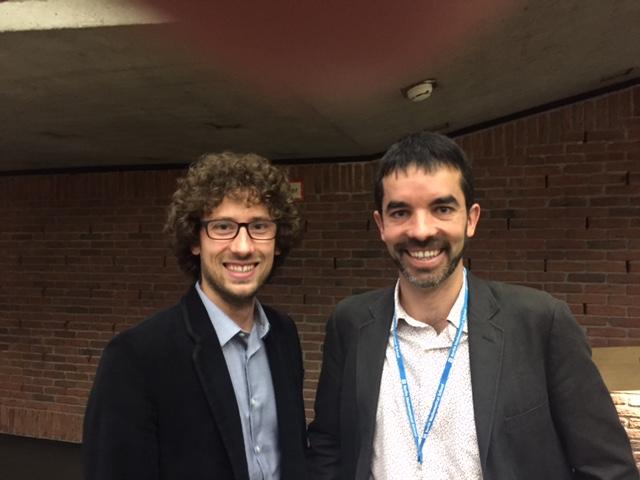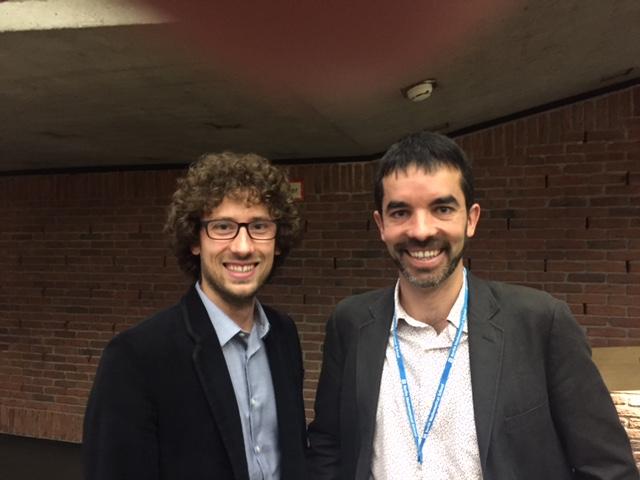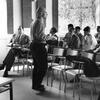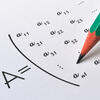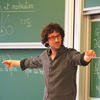You are here
EMS Prizes for French Mathematicians
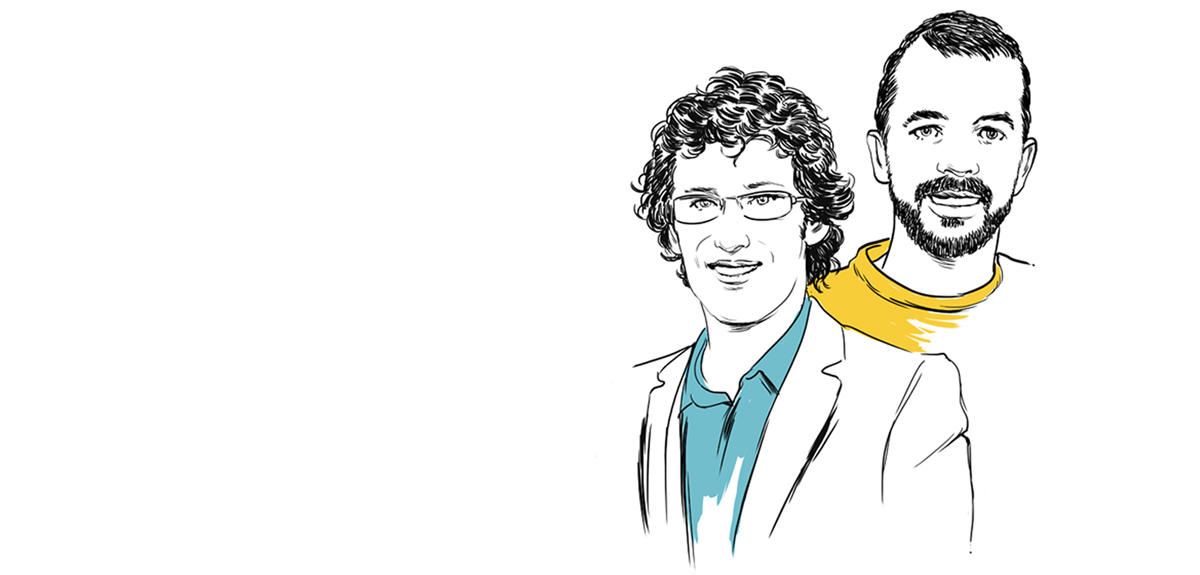
The European Mathematical Society (EMS), whose congress is being held July 18-22 in Berlin, has rewarded among others the French mathematicians Hugo Duminil-Copin and Vincent Calvez. The EMS holds a congress every four years where it awards a total of 12 prizes to outstanding mathematicians, 10 of which to young researchers in mathematics under 35 who are either European or currently hold a position in Europe. This meeting brings together European mathematicians two years before the International Congress of Mathematicians (ICM), which is also held every four years and awards the prestigious Fields Medals, widely regarded as the Nobel of mathematics.
The EMS prizes are sometimes portrayed as a forerunner to the famous Fields medals. Artur Avila, Cédric Villani and Wendelin Werner, respectively laureates of the Fields Medal in 2014, 2010, and 2006, were also distinguished by the EMS. Since the launch of these European prizes in 1992, there have been 18 French laureates, four of whom women. We asked Christoph Sorger, Insmi1 director at the CNRS, to tell us more about the two young French mathematicians rewarded in Berlin.
One of the laureates of the European Mathematical Society (EMS) prize is Hugo Duminil-Copin, a probability theorist…
Christoph Sorger: He is even considered to be one of the most brilliant probability theorists of his generation. And let’s remember that he’s only 30 years old… He studied at the Ecole Normale Superieure in Paris where he got his teaching degree. He currently holds a position at the University of Geneva, but will joining the Alexander Grothendieck2 laboratory in Bures-sur-Yvette this September. And we couldn’t be happier. His return to the French school of mathematics will bolster the already strong levels of probability theory expertise found in our laboratories. It is in fact for his work in probability that Wendelin Werner was awarded the Fields Medal in 2006.
Every high-school student eventually deals with probability theory, whether it be problems linked to throwing dice, or drawing playing cards. What is Hugo Duminil-Copin’s specific area of research?
C. S.: His main topic of research has to do with something called “random walk.” This is in fact a succession of random footsteps, each independent from the last, as if the person walking was constantly forgetting where he was going: this is why we sometimes refer to it as a “drunkard's walk.” Hugo Duminil-Copin was able, among other things, to determine, with Stanislav Smirnov, a constant that characterizes the number of possible paths of self-avoiding random walks (never stepping twice in the same place) when the walker moves on a two dimensional honeycomb lattice. This work has its basis in fundamental research, but random walks are often used to model Brownian motion of particles in a gas, and have a number of applications in physics.
In general, probability theory is a branch of mathematics that is increasingly called on for applications linked to new technology, especially for cryptography, a key area of computer science…
C. S.: Absolutely, in many cases, when a problem cannot be explicitly solved, we can choose another approach: to calculate the probability that such a result is correct, and agree on a value whereby this probability will be deemed acceptable. And this approach is indeed very useful for cryptography.
The other laureate, Vincent Calvez, applied his math to biology…
C. S.: Yes, a researcher at the UMPA3 and member of Inria’s NUMED4 team, he works on applied mathematics for biology. More precisely, his work focuses on describing the living and collective motion using equations. In fact, he obtained his thesis at UPMC-Paris 6, under the direction of Benoît Perthame, the French leader in the field of “bio” math, which calls on partial differential equations. Vincent Calvez then worked on modeling the motion of cell clusters. And, in 2014, I had the honor of awarding him the CNRS Bronze Medal for his team’s work on modeling the motion of bacteria in a liquid and calculating their individual and collective speeds. This study continues today as an ERC5 project. An amusing anecdote is that this model was developed by adapting equations that originally described the cane toad invasion of Australia.6
The link between bacterial movement and cane toads is not evident—how are the two related?
C. S.: Colonies of bacteria and toad populations both have a motion strategy that integrates a strong heterogeneity of individual movements. This means that the movement of each individual does not necessarily follow the general direction or speed of the group at large. It was therefore insightful, in both cases, to use a model that was at a mesoscopic scale— between the two levels of motion, individual and collective. But in their model, Vincent Calvez and his team also included information at the microscopic level, described by kinetic transport equations.
It seems that biology offers great potential for mathematical applications. Can you give us a few other examples?
C. S.: Indeed, its scope is very wide, but the idea is often the same: we try to model objects—using equations—to predict future behavior. For example, we model tumor growth to try to make correct predictions on how they will evolve. And this, for example, can help doctors determine the efficacy of a treatment by comparing the observed evolution to the evolution predicted by the model. Another example is Big Data—the massive amounts of information that we can now tap to develop automatic medical diagnostic tools, which can use physiological signals monitored by a smart watch or other devices. Finally, the rapidly expanding field of genetics also provides exceptional opportunities for mathematics.
A last word on the two laureates and their awards?
C. S.: We are very pleased to see probability theory and applied mathematics in biology rewarded this year, as these are two strategic branches of our discipline. Prizes that reward young researchers are especially important for science agencies like the CNRS, which strives to encourage and foster new talent. I am convinced that the very prolific careers of our two French laureates, Hugo Duminil-Copin and Vincent Calvez, are only just beginning.
Update: A third French mathematician was honored at the 7th Congress of the EMS: the Felix Klein Award was given to Patrice Hauret, team leader at France’s Michelin Technology Center. This prize recognizes a young scientist or group of scientists who were able to use sophisticated methods to solve challenging industrial problems. To learn more about his research, a profile is available on the EMS website.
- 1. Institut national des sciences mathématiques et de leurs interactions.
- 2. CNRS / IHÉS.
- 3. Unité de Mathématiques Pures et Appliquée (CNRS / ENS Lyon / Inria).
- 4. Modélisation numérique en medicine.
- 5. European Research Council.
- 6. The formalism, which has described this invasion since the 1930s, was imagined by Laurent Desvillettes (ENS Cachan), Sylvie Méléard (École polytechnique) and Régis Ferrière (ENS Paris).
Explore more
Author
Science journalist, author of chilren's literature, and collections director for over 15 years, Charline Zeitoun is currently Sections editor at CNRS Lejournal/News. Her subjects of choice revolve around societal issues, especially when they interesect with other scientific disciplines. She was an editor at Science & Vie Junior and Ciel & Espace, then...


